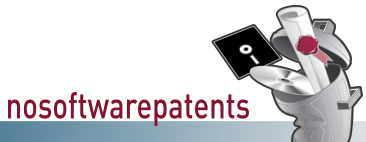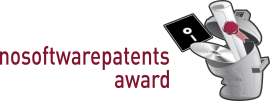| English | Deutsch |

![- Logo]](../images/layout007-small.png)
| Home |
| Software Patent of the year 2006 |
| About |
| Supporters |
| Background |
| News |
| Press November |
| Links |
| Contact |
| Imprint |
May – Patent 2
- EU-Patent on software (algorithm)
- Application to European Patent Office on 28/11/2000 by International Business Machines Corporation (USA)
- Granted on 08/02/2006
- Date of priority: 11/01/2000 (valid no more than until 11/01/2020)
- Patent Attorney: Patent department of the company
- Patent specification provided by FFII/Gauss
- Patent specification provided by EPO/espacenet
- The decisive element are the claims, as they specify which actions are forbidden within the framework of the patent.
- Violating one single claim is sufficient to be considered a patent violation. Generally, claim number 1 is the decisive main claim which covers all other claims relating to special cases.
- The description is intended to help the reader interpret the claim. At the same time, it is supposed to document and disclose the details of the invention. This disclosure is the original purpose of the entire patent system.
- In practice, a patent specification contains no detailed information on how the patented procedure could be implemented (even if the patent owner allowed the implementation). In particular, a software patent contains no program code (reference implementation), but merely describes the idea of a software.
Patented idea: Inserting an authentication code in a text by means of additional blanks.
Main claim: Marking a text document by means inserting extra blanks on selected positions which result from the authentication code ("secret key").
Further claims:
- Verifying whether a text document is marked with extra blanks at the right positions
- Insertion of three blanks at the end of the line.
- No insertion of three blanks at the end of the line.
- Minimize, by any means, the likeliness to get the same result by sheer coincidence.
- To determine the positions of the blanks by means of a pseudo-generator of numbers the start value of which is given by the secret key and the text (digest or hash function)
- Computer on which the software runs
- The software on the data storage medium
Description: The patent specifications indicate
- that the patented method inseparably integrates the authentication code in the text,
- that there would be more memory space if the text had been saved as graphic data, even when it would be easier to insert there additional information
- that the patented method is proper both for the digital and the printed texts and
- that the reader does not usually notice the additional blanks.
The "finding" is illustrated with an example which comprises a concrete generator of numbers. Thus a prime number with 27 positions appears, which surely makes a very strong impression on mathematical laymen.
Everyday life parallel: Kevin wants to talk with Anna. He writes a note with the hour and place of the date and sends it to her during the mathematics class. As Kevin knows that the other joung men want to annoy him and to give Anna additional notes with false information, he has agreed with her to use a secret code: "The note is really from me when there are two small squares after the second and fifth word and only one elsewhere".
Examples of patent infringement:
- If one replaces in the above-mentioned everyday life example the transport medium "note" with "E-mail" and automates the additional blanks, one can obtain a real patent infringement.
- The stenography software SNOW (described in 1996) inserts arbitrary additional information in the text – thus also the authentication code – by means of additional blanks at the ends of the lines. Thus the additional information can be made safe through codification.
- Also the programming language Whitespace uses the idea to codify the blanks. The Whitespace programming tool embed infringes the patent if one uses a Whitespace source text as authentication code.
| Previous Software Patents of the Month |
| > September |
| > August |
| > July |
| > June |
| > May |
| Patent 1 | |
| Patent 2 | |
| Patent 3 | |
| Patent 4 | |
| Patent 5 |
| > April |
| > March |
| Press Archive |
| > Oktober |
| > September |
| > August |
| > July |
| > June |
| > May |
| > April |
| > March |
